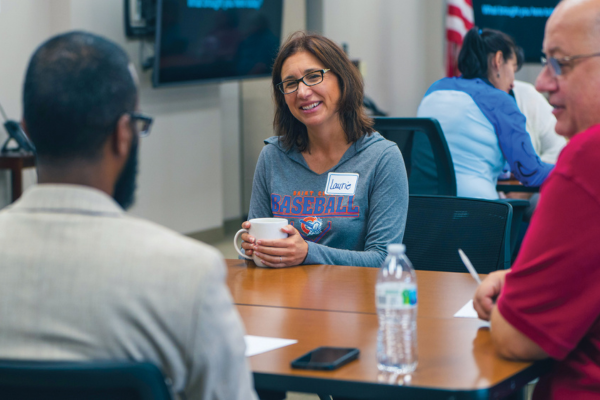Relationships Are Fundamental
September 01, 2018

Harvard researcher Stephanie Jones on the essential elements of social and emotional learning

You might not expect an expert on social and emotional learning to turn to “Supernanny,” a reality television program, for parenting advice, but that’s what Harvard University’s Stephanie Jones, a professor of education, found
herself doing late one night.
A busy working mother, Jones identified with the show’s stressful situations. She happened to catch the Supernanny advising a mom with a similar challenge at the end of each day.
“She
said, ‘When you come home, force yourself to ignore the demands that prevent you from reconnecting with your children. Let them fall all over you and have their moment of crying, needing you, whatever. Then you’ll have the entire evening
to get things done,’” Jones said. “I tried it, and it made a big difference.”
Jones tells this story because it highlights one of the fundamental insights of her work on social-emotional learning in youngsters.
When adults carefully consider how they interact with children, everyone benefits. “It’s true for parents but also teachers,” she says.
Her research background extends beyond social-emotional learning to cover conflict
resolution and character education. She has studied how school-based programs are implemented, how barriers can be addressed and what effects these programs have on schools, teachers and children.
Jones’ research, commissioned
by The Wallace Foundation, the Aspen Institute and the Collaborative for Academic, Social and Emotional Learning, links children’s social and emotional learning to later success. In an interview for School Administrator, she talked
about why superintendents and other educators should care about SEL and what research tells us about using these instructional support measures in schools.
The Q&A has been edited for clarity and length.
What drew you to social-emotional learning as an area of study?
JONES: A lot of the work I did early on focused on poverty and other forms of risk and the relationship between those factors and children’s developmental trajectories. That work painted a picture
that neuroscience is confirming today: Stress, trauma and turmoil set up a dynamic in the brain and in behavior that puts children at a disadvantage. So I came to focus on what kinds of strategies, practices and interventions make a difference
in this dynamic.
Why does social-emotional learning matter?
JONES: We start with the idea that social, emotional and behavioral skills have their roots in interactions and relationships. We then move to the idea that interactions and relationships are fundamental to the educational enterprise.A focus on these skills drives positive academic outcomes, behavioral outcomes, long-term outcomes, relationships with adults, and more engaged, interesting, emotionally supportive learning settings.
When we talk about SEL, what skills are students actually learning?
JONES: We organize the skills into a few categories. There are cognitive skills like working memory, attention control, response inhibition, goal-setting, planning. There are emotional competencies like “emotion knowledge” — being able to understand emotions in oneself and others, using them to build empathy.Then there’s a social category that includes being able to read the social environment and respond to it appropriately, having pro-social inclinations like wanting to help and cooperate.
Can you elaborate?
JONES: Whether you describe self-regulation as self-control or even grit, these concepts are deeply tied to the process of learning. You have to be able to manage your attention. You have to be able to minimize distractions. You need to be able to negotiate and manage in groups with other children or with adults.You argue that social and emotional skills are “malleable,” meaning they can be taught and developed throughout childhood, adolescence and beyond.
What role does age play in SEL? How should SEL education evolve as children age?
JONES: When I talk about how social emotional skills are malleable, I mean two things. One is that they emerge and change over the course of human development.Those first years of schooling — pre-K, K and 1st grade — are when the prefrontal cortex is expanding, and it’s a big opportunity to focus on [core executive functions] like self-control, working memory, and attention shifting. Those set the stage for further development. In 3rd grade, for example, children need to be able to set out a plan and follow it. They need to organize their materials and be in charge of their backpack. Those are more sophisticated versions of those basic executive functions.
The second thing I mean by malleable is that research shows you can design strategies and practices that support the acquisition of these skills. The thing that’s important to remember is that not all skills are critical at every period. You wouldn’t necessarily expect a 4-year-old to be sophisticated at social problem solving.
What is the specific role of schools in supporting social and emotional learning?
JONES: The goal of schools is to provide children and youth with content knowledge but almost more importantly,
skills in learning, to build their capacity to take in knowledge, manipulate it, understand it and share it. That process demands social and emotional skills.
Social-emotional learning is happening all the time, in school and out.
The question is, how do we get explicit and intentional about it in order to maximize the learning outcomes we care about?
What do we know about the potential return on investment for SEL?
JONES: We now have evidence that implementing a program or set of strategies that builds social and emotional skills results in a boost not only in those skills but in academic outcomes, things like attendance and scores on standardized tests. The effects are even stronger for children who struggle with behavior. That’s not even counting longer-term outcomes, including health, wealth, reduced criminality and substance abuse.What are the ingredients of effective SEL?
JONES: It boils down to two things. One is instruction. The other is creating an environment that kids experience as safe, caring, supportive, engaging
and motivating.In the instruction category, SEL is generally effective if it has four elements:
(1) Adults model the skills they’re trying to build with children and youth. You can’t have adults yelling at children about their emotions.
(2) Skills are made explicit. An example I frequently use is attention. We say to children all the time, “Pay attention,” but do we teach them what attention means? What does paying attention feel like? What might you do to show someone you’re paying attention?
(3) Practice opportunities are available. Effective SEL instruction isn’t confined to one part of the day. Children are using attention during math or science or gym or lunch. You can use that time to talk about attention. “I noticed you zoned out a little there. What was happening in your brain?”
(4) Making the language of SEL part of the discourse. For example, an adult who supervises recess might notice when children are having big emotions and talk to them about it. And that means working with adults on their social and emotional skills, supporting them in effective classroom and behavior management.
You mentioned that school environment is important. What is the connection between SEL and school culture?
JONES: SEL is about more than just targeting and building skills. Certain aspects of the school environment can make it more or less challenging to learn and use those skills. For example, a child is much more likely to pay attention to their teacher and get along with their peers in a classroom and school community where they feel connected, engaged and accepted.For this reason, efforts to support SEL and improve school culture and climate can often be mutually reinforcing. School culture and climate initiatives that support SEL might include establishing a clear set of pro-social norms, promoting positive school discipline and classroom management, and supporting teachers and students to build healthy relationships with one another.
Any research on this that superintendents would find valuable?
JONES: Research shows that school culture/climate efforts can support children to develop and use SEL skills in two important ways. The first is through the quality of adult-child relationships in the building. A large body of research shows that warm and trusting relationships between teachers and children lead to improved SEL skills and school adjustment while negative relationships lead to poor behavior and academic outcomes.Second, children are more likely to benefit from SEL programs when the programs are embedded in everyday actions and school culture, meaning that successful SEL efforts should extend beyond the classroom to playgrounds, lunchrooms, hallways and bathrooms and support teachers and students to use SEL strategies more broadly during their daily interactions.
What common pitfalls should educators watch for?
JONES: The perception can be that, to make a new program fit, you have to eliminate something else. Schools often decide to put SEL, say, in health and wellness class but nowhere else. In fact, SEL is most effective when it’s woven into everyday practice. That’s not easy, but when leaders get behind it, they do see positive outcomes.SEL can’t just be checked off by simply adopting a program. You have to make it a priority and think carefully about what will make implementation stick and connected to the work of the school.
Another pitfall is the tendency for adults to not notice when they are breaking a norm they expect of children. I was dropping my son off at school one day and he had something he wanted to tell his teacher. She was talking to someone else, and he ran over and interrupted. She said, “When an adult is speaking to another adult you have to wait and not interrupt.” And he said, “But why do you get to interrupt us?” Children are highly attuned to these inconsistencies. [W]hich means you need to provide support to adults as well as children.
What key points should superintendents take away from this interview?
JONES: First, social-emotional learning is important. Attending to it makes a demonstrable difference to children, youth and the overall school culture. Second, there are many ways school districts can address this body of skills, including curriculum, instruction and policies. Third, it takes time, attention and effort. Lastly, you don’t just focus on SEL for its own sake; by weaving it into the system, you can accelerate other kinds of positive outcomes.Author
“ Navigating SEL from the Inside Out,” a consumer-oriented guide produced with support from The Wallace Foundation, provides references to 25 leading, evidence-based social and emotional learning programs.
The practical guide profiles each program, including the specific skills targeted and instructional methods used. It includes a summary of the evidence base for each program and a series of tables that makes it possible to compare features. Readers can see at a glance that one program is designed to help students regulate their behavior, while another is aimed at developing a particular character trait like empathy or that one offers support for engaging families, while another can be adapted to serve specific populations.
The guide includes a set of worksheets to help readers put this information to practical use.
Advertisement
Advertisement
Advertisement
Advertisement



